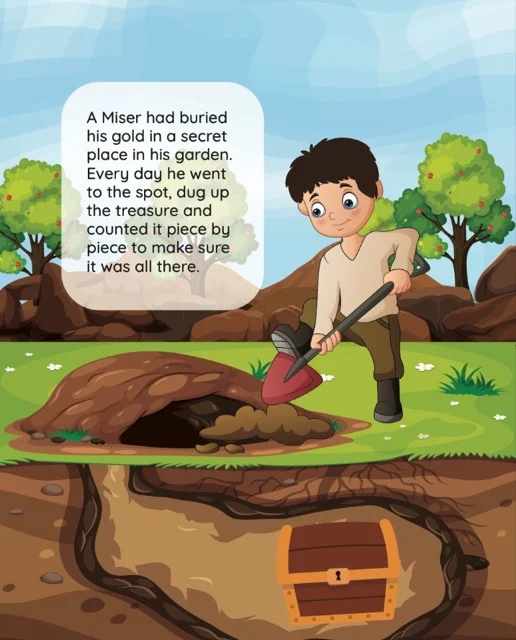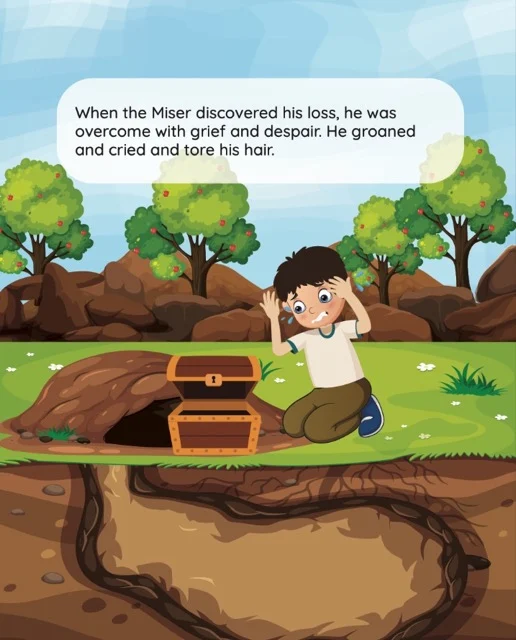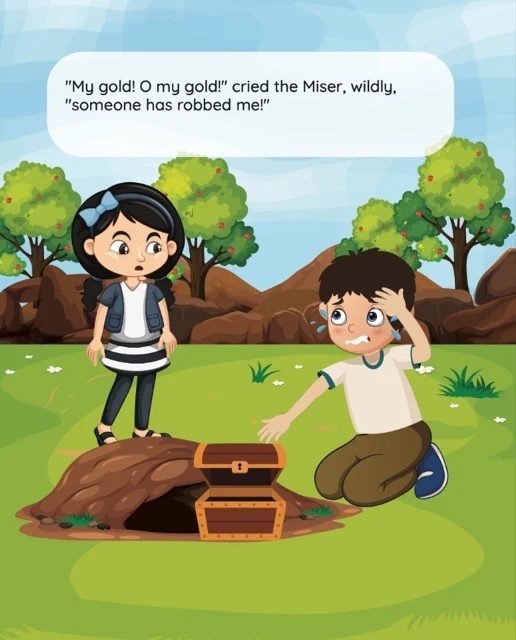The Miser's Gold: A Fable of Materialism
"The Miser's Gold" is a fable illustrating the futility of materialism. A miser's sole happiness derives from possessing gold, not using it, leading to despair when it's stolen. The story uses symbolism, with the gold representing misplaced values, and a passerby's suggestion to replace it with a stone highlights the absurdity of his attachment. The fable's timeless message warns against prioritizing material wealth over genuine experiences and relationships, effectively conveyed through a visual comic strip format.
The Miser's Gold: A Fable of Materialism
Briefing Doc: The Miser and His Gold
Main Themes:
●
The Futility of Hoarding Wealth: The story centers on a miser who derives his sole pleasure from possessing gold, not from using it. His attachment brings him no real happiness and ultimately leads to despair when the gold is stolen. This highlights the emptiness of prioritizing material wealth over experiences and relationships.
●
The Value of Perspective: The passerby offers a contrasting viewpoint, suggesting the miser replace the gold with a stone. This emphasizes that the miser's satisfaction stemmed from the act of looking at his perceived wealth, not the actual gold itself. This challenges the audience to reconsider their own attachments and what truly holds value.
Key Facts & Ideas:
●
The Miser's Obsession: The miser loves his gold above all else, keeping it buried and visiting it daily for the sole purpose of admiring it. ("The miser loved his gold more than anything else in the world... Every day, the miser went to the hole and dug up his gold just to look at it and admire it.")
●
Loss and Despair: The miser's world is shattered when his gold is stolen, leading to extreme emotional distress. This underscores the fragility of happiness built on possessions. ("The miser was utterly devastated... He cried, tore his hair, and lamented his fate.")
●
The Passerby's Advice: The passerby's advice to replace the gold with a stone highlights the absurdity of the miser's attachment. If the act of looking provided satisfaction, the object itself was irrelevant. ("The passerby told the miser that he should simply place a stone in the hole and pretend it was his gold... a stone would serve the same function.")
●
Genre and Symbolism: The story belongs to the genre of fables or parables, employing symbolism to convey its message. The gold represents not just wealth but also the dangers of material attachment and misplaced values.
Quotes:
●
"The miser loved his gold more than anything else in the world. He spent all his time thinking about it and protecting it."
●
"Every day, the miser went to the hole and dug up his gold just to look at it and admire it. This brought him immense satisfaction."
●
"The miser was utterly devastated by the loss of his gold. He cried, tore his hair, and lamented his fate."
●
"The passerby told the miser that he should simply place a stone in the hole and pretend it was his gold... So, for all practical purposes, a stone would serve the same function."
Significance and Relevance:
●
Visual Storytelling: The comic strip format enhances the story's impact through visuals, making the miser's actions and emotions more vivid.
●
Timeless Message: While a classic fable, the story's message resonates with contemporary society where materialism and consumerism are prevalent. It serves as a reminder to examine our priorities and find true wealth in experiences, relationships, and helping others.
The Miser and His Gold
FAQ: The Miser and His Gold
1. What did the miser love most in the world?
The miser loved his gold more than anything else in the world. He spent all his time thinking about it and protecting it.
2. Where did the miser keep his gold?
The miser kept his gold buried in a hole in the ground. He thought this was the safest place for it.
3. What did the miser do every day?
Every day, the miser went to the hole and dug up his gold just to look at it and admire it. This brought him immense satisfaction.
4. What happened one day when the miser went to check on his gold?
One day, the miser went to his hiding spot and found that his gold was gone! Someone had stolen it.
5. How did the miser react to the theft?
The miser was utterly devastated by the loss of his gold. He cried, tore his hair, and lamented his fate. He couldn't understand how someone could have taken his precious treasure.
6. Who offered the miser advice?
A passerby, seeing the miser's despair, approached him and inquired about the cause of his sorrow. After listening to the miser's tale, the passerby offered him some advice.
7. What advice did the passerby give the miser?
The passerby told the miser that he should simply place a stone in the hole and pretend it was his gold. After all, he never used the gold for anything, only looked at it. So, for all practical purposes, a stone would serve the same function.
8. What is the moral of the story?
The story of the miser and his gold teaches us that wealth has no value if it is not used. Hoarding possessions only leads to anxiety and unhappiness. True wealth lies in experiences, relationships, and helping others.
The Miser and His Gold: A Study Guide
Understanding "The Miser and His Gold"
Quiz
Instructions: Answer the following questions in 2-3 sentences each.
1.
Describe the miser's daily routine regarding his gold.
2.
How did the miser react when he discovered his gold was missing?
3.
What advice did the passerby offer to the miser?
4.
Explain why the passerby believed his advice would be helpful to the miser.
5.
What is the primary theme explored in the story?
6.
What literary genre does this story belong to?
7.
How does the visual medium of the comic strip contribute to understanding the story?
8.
What is the significance of the miser's emotional response to the theft?
9.
How does the setting of the story contribute to its overall meaning?
10.
If you were to write a sequel to the story, what might happen next?
Answer Key
1.
The miser's daily routine involved going to the hole where he buried his gold and digging it up simply to look at it and admire it. This act gave him immense satisfaction.
2.
The miser reacted with extreme despair when he found his gold stolen. He cried, tore his hair, and lamented his fate, expressing his profound sorrow and inability to comprehend the loss.
3.
The passerby advised the miser to place a stone in the hole and pretend it was gold. He reasoned that since the miser never used the gold but only looked at it, a stone would serve the same purpose.
4.
The passerby believed his advice would help the miser because he saw that the miser derived satisfaction merely from the act of looking at his gold. Replacing the gold with a stone would allow the miser to continue this routine without the anxiety of possessing actual gold.
5.
The primary theme of the story is the futility of hoarding wealth. The miser's obsession with his gold brought him no real happiness and ultimately led to despair when it was stolen.
6.
The story belongs to the genre of fables or parables, which are short tales that convey a moral lesson.
7.
The visual medium of the comic strip enhances the story by providing a clear depiction of the miser's actions and emotional state. The visuals emphasize his obsession with the gold and the dramatic impact of its loss.
8.
The miser's emotional response highlights the story's message about the dangers of attachment to material possessions. His exaggerated grief underscores the idea that misplaced values can lead to profound unhappiness.
9.
The isolated setting of the story, focusing on the miser and his hidden treasure, emphasizes his detachment from the world and reinforces the idea of his solitary and ultimately empty existence.
10.
Answers will vary.
Essay Questions
1.
Analyze the character of the miser. What motivates his actions? What are his flaws?
2.
Explore the symbolism of gold in the story. What does it represent to the miser? What broader meanings might it hold?
3.
Discuss the role of the passerby in the story. Is he a helpful figure or simply a commentator? How does his presence contribute to the story's overall message?
4.
Compare and contrast the miser's worldview with a worldview that values experiences and relationships over material possessions. Which perspective do you find more compelling and why?
5.
Consider the relevance of the story's message in contemporary society. Do you believe the story offers valuable insights into the dangers of materialism in modern life?
Glossary of Key Terms
Miser: A person who hoards wealth and spends as little money as possible.Gold: A precious metal often symbolizing wealth, power, and greed.Hoarding: The act of accumulating and hiding possessions excessively.Passerby: A person who happens to be walking by and witnesses an event.Fable: A short fictional story, typically featuring animals, that conveys a moral lesson.Theme: The central idea or message explored in a literary work.Symbolism: The use of objects or images to represent abstract ideas or concepts.Materialism: A preoccupation with material possessions and wealth.Parable: A simple story used to illustrate a moral or spiritual lesson.










